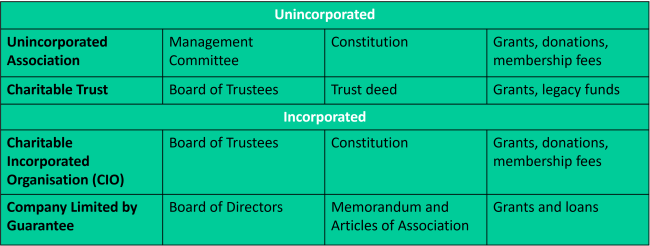Getting started
A charity's legal structure establishes how your group will be run, how decisions will be made and how formal the organisation needs to be.

In the same way there are many reasons to form a charity, there are many different types of charity you can set up. This is known as its legal structure.
When choosing your legal structure, start by deciding whether your charity will be unincorporated or incorporated.
An unincorporated charity doesn't have its own legal personality. Contracts must be signed by a trustee who can then be held personally liable for any debts. If you are a group of people wanting to organise something on a small budget, who don't want to employ staff or lease premises, an unincorporated structure will likely suit you.
An incorporated charity gives the charity its own legal personality, meaning it can own property or sign contracts in the charity's name. This gives trustees greater protection from being personally liable. Charities which employ people or promise to provide services, normally choose to be incorporated.

To be a charity, an organisation must have purposes (aims) stating what it's set out to achieve. These purposes must correspond to one or more of the 13 charitable purposes for the public benefit. Look at examples of charitable objects (purposes) from the Charity Commission or search the purposes of registered charities with similar aims, to help write yours.
Choosing the name for your charity is fun - but there are a few things to be aware of first. Search the register of charities to check you're not using the name of another charity.
Other useful guidance
The How to Do it For East Yorkshire site has a really helpful 'decision tree' to help identify the most appropriate legal structure for you to adopt. Visit the site HERE.






